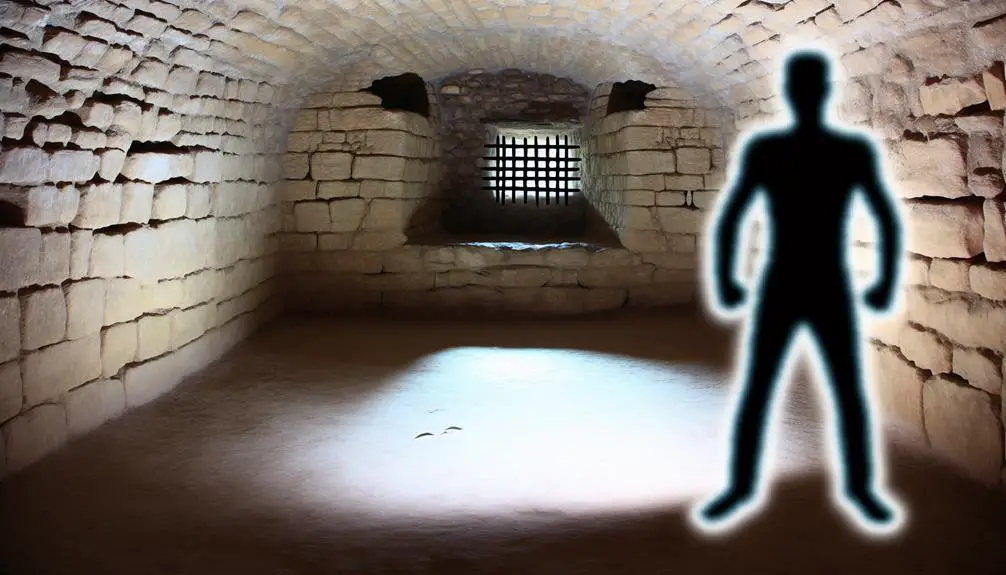Curious about the lesser-known Jesuses of the Bible? Discover their unique stories and the intriguing implications behind their shared name.

Other Jesuses in the Bible
You've heard of Jesus Christ, the central figure of Christianity, but have you encountered the other Jesuses within the Bible's pages?
From Jesus Barabbas, the notorious prisoner, to Jesus Justus, Paul's fellow worker, these namesakes present a fascinating layer of biblical history and interpretation.
Each carries a story that not only adds depth to the biblical narrative but also challenges our understanding of the era's naming conventions and the significance of 'Jesus' in various contexts.
Exploring these figures will offer you a unique perspective on the diverse tapestry of biblical characters, leaving you pondering the complexities of historical and religious identities.
Key Takeaways
- The name Jesus, beyond Jesus of Nazareth, references diverse biblical figures with distinct roles and historical contexts.
- Jesus Barabbas and Jesus Son of Sirach highlight the broad spectrum of moral and social themes addressed in the Bible.
- Figures like Jesus Justus and Joshua, though sharing the name, played pivotal roles in the formation and leadership of early Jewish and Christian communities.
- The variety of characters named Jesus in the Bible illustrates the complexity of religious, ethical, and cultural narratives within biblical literature.
Jesus Barabbas: The Notorious Prisoner

In the narrative of the Gospels, Jesus Barabbas emerges as a complex figure, whose notoriety and eventual release underscore the political and social tensions of the time. Barabbas, known for his criminal activities, becomes central to a pivotal moment where the choice of his freedom over Jesus of Nazareth's reflects broader societal conflicts and values. This incident, often seen through the lens of religious and ethical discussions, also serves as a stark illustration of the dynamics of power, authority, and public influence in ancient Judea.
The decision to release Barabbas, a known insurgent and murderer, over a preacher advocating love and peace, reveals the intricate interplay between the Roman authorities and the Jewish populace. The choice, ostensibly left to the public by Pontius Pilate, highlights the complexities of governance, persuasion, and the use of criminal release as a tool for managing public sentiment. This episode not only showcases the volatility of public choice but also sheds light on the strategic considerations of colonial rulers in maintaining control and order.
Analyzing Barabbas' release, one must consider the multifaceted nature of historical, political, and social contexts that influenced such decisions, reflecting on how power, public opinion, and justice intersect in times of upheaval.
Jesus Justus: Paul's Fellow Worker
While less notorious than Barabbas, Jesus Justus plays a significant role as one of Paul's fellow workers, contributing to the early Christian movement with dedication and perseverance. His involvement, though not widely discussed, is a testament to the collaborative effort required to spread the teachings of Christianity during its nascent stages. As you delve further into the dynamics of Paul's teamwork, a closer examination of Jesus Justus's contributions offers insightful perspectives into the early Christian community.
In the context of Paul's teamwork, the Epistle mentions involving Jesus Justus are crucial for understanding the interconnectedness of early Christian workers. These mentions highlight:
- The nature of Jesus Justus's work alongside Paul, emphasizing the collaborative spirit that was essential for the early Church's growth.
- His commitment to the cause, as seen through the lens of Paul's letters, which underscore the value of every contributor, no matter the scale of their contributions.
- The specific roles he might've played, though not detailed, suggesting a multifaceted approach to spreading the Gospel.
- The implication that his efforts were noteworthy enough to be recorded, underscoring the importance of collective action in the early Christian movement.
Analyzing Jesus Justus's role within Paul's teamwork framework provides a nuanced understanding of the early Christian community's efforts to establish a new religious movement.
Joshua: Jesus' Namesake

Exploring the significance of Jesus Justus offers a foundation to understand Joshua, whose name shares profound linguistic and historical connections with Jesus, serving as a pivotal figure in biblical narratives. Joshua's role as a leader, particularly in military contexts, underscores the importance of his name, which, like Jesus, means "Yahweh is salvation". This name significance is not merely nominal but reflects the depth of his mission and the fulfillment of divine promises through his military leadership and conquests.
To further elucidate Joshua's role and its connection to Jesus, consider the following table that highlights key aspects of Joshua's life and leadership:
Aspect |
Description |
Significance |
|---|---|---|
Name Origin |
"Yahweh is salvation" |
Echoes the salvific mission similar to Jesus |
Role |
Military leader |
Embodies divine guidance and victory |
Biblical Significance |
Successor to Moses; leads Israelites |
Symbolizes new beginnings, faithfulness |
Legacy |
Establishes Israel in Promised Land |
Paves the way for future divine interventions |
Joshua's story is a testament to the power of divine leadership and the fulfillment of promises, encapsulated in a name that prefigures the salvation brought forth by Jesus Christ.
Jesus Son of Sirach: Wisdom's Author
Shifting focus, it's essential to consider Jesus Son of Sirach, a pivotal figure renowned for authoring the Wisdom of Sirach, a cornerstone of biblical wisdom literature. His contribution isn't just a mere inscription; it's a profound compilation that has significantly influenced the way wisdom is perceived and valued in religious contexts.
Sirach's teachings encapsulate:
- Moral Conduct: Sirach emphasizes living a life of virtue, integrity, and righteousness. His writings advocate for ethical behavior as the foundation of a meaningful existence.
- Fear of the Lord: Central to Sirach's teachings is the fear of the Lord, which he posits as the beginning of wisdom. This reverential awe and respect for God are deemed crucial for acquiring true knowledge.
- Practical Wisdom: Unlike some other wisdom literature that leans towards the philosophical, Sirach's work is grounded in practical wisdom that applies to daily life, advising on everything from governance to personal relationships.
- Preservation of Tradition: He underscores the importance of preserving Jewish tradition and law, bridging the past with the present through a continuum of wisdom.
Jesus Son of Eliezer: A Lesser-Known Figure

In the tapestry of biblical narratives, Jesus Son of Eliezer emerges as a lesser-known figure, whose story and contributions warrant closer examination for their nuanced insights into the period's religious and social dynamics. Positioned within the broader historical context, Jesus Son of Eliezer's presence in textual references may seem fleeting, yet it opens a window into the complex fabric of first-century Judea.
Analyzing the scant textual references that mention Jesus Son of Eliezer, you uncover layers of meaning that extend beyond mere names. These references serve not only as historical markers but also as entry points into understanding the varied landscape of religious thought and practice of the time. His mention within sacred texts suggests a figure who, albeit peripheral, played a role in the unfolding narrative of his community's struggle, faith, and identity.
The historical context surrounding Jesus Son of Eliezer enriches your grasp of the period, highlighting the diversity of voices and perspectives that coexisted. It challenges you to consider the interplay between individual lives and the broader socio-religious currents they navigated. Through a closer look at Jesus Son of Eliezer, you gain insights into the texture of life and belief in a pivotal era of religious history.
Frequently Asked Questions
How Have the Depictions of These "Other Jesuses" Influenced Theological Discussions and Debates Within Early Christian Communities?
The depictions of Jesus' contemporaries have significantly shaped theological discussions within early Christian communities.
You'll find that these portrayals led to varied interpretations about his teachings and life, creating a rich tapestry of belief systems.
The doctrinal implications were profound, as debates over the nature of Jesus and his message prompted early Christians to deeply consider their faith's foundations.
This diversity in understanding has left a lasting impact on Christian theology.
Are There Any Known Artistic Representations of These Less Prominent Jesuses, and How Have They Evolved Over Time?
You're diving into a world where art and culture collide, seeking the shadows of figures less illuminated by history's spotlight.
When exploring artistic influences and cultural representations, it's clear there's a rich tapestry of images evolving over time. These depictions, though not always front and center, have subtly shaped perceptions and understanding through their visual narratives.
Analyzing these artworks reveals not just an evolution of style but of societal and theological reflections.
In What Ways Have Apocryphal Texts Contributed to Our Understanding or Misunderstanding of These Figures?
Apocryphal texts have significantly shaped your understanding of biblical figures by blurring lines between authenticity and folklore. These writings, often excluded from the canonical Bible, offer intriguing insights yet pose challenges in distinguishing historical facts from pious fiction.
The textual influence of these apocrypha extends beyond mere curiosity, impacting theological perspectives and prompting scholarly debates over their authenticity. They've enriched, yet complicated, the exploration of biblical narratives and characters.
Can the Mentions of These Other Jesuses Be Found in Non-Christian Religious Texts or Historical Accounts From the Same Period?
Diving into the sea of ancient texts, you'll find that mentions of figures akin to Jesus do appear in non-Christian religious writings and historical records, illuminating the tapestry of cross-cultural comparisons.
These literary influences offer a unique lens to view how diverse cultures might've perceived or even integrated the narrative of Jesus-like figures.
Analyzing these accounts, you'll uncover a rich interplay of stories that transcends the confines of a single religious tradition.
How Do Modern Scholars Differentiate Between Mythological Embellishments and Historical Facts When Studying These Other Jesuses?
When you're delving into how scholars discern myth from fact, you'll find they heavily lean on archaeological evidence and linguistic analysis. They scrutinize artifacts and historical documents, comparing linguistic patterns and cultural contexts to peel away layers of mythological embellishments.
This approach helps them to construct a more accurate historical narrative, distinguishing what's likely factual from the purely legendary. It's a meticulous process, blending science with scholarly interpretation to uncover the truth.
Conclusion
In the tapestry of biblical narrative, these 'other Jesuses' serve as vibrant threads, interwoven with the central figure of Jesus Christ, yet distinct in their hues. Each character, from Barabbas to Jesus Son of Eliezer, embodies a unique aspect of human experience and divine interaction, mirroring the multifaceted nature of faith itself.
Their stories, while shadowed by the greater narrative, enrich our understanding, offering a kaleidoscope through which to view the complexities of scripture and spirituality.



Sign up